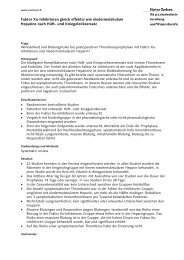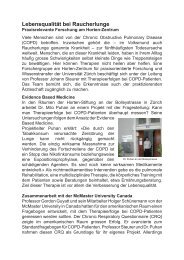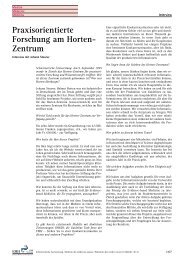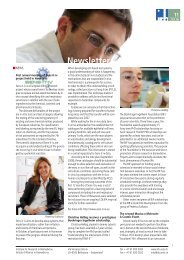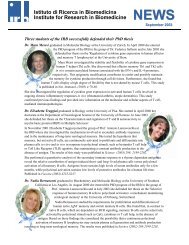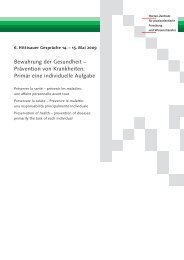Annals of Internal Medicine - Helmut Horten Stiftung
Annals of Internal Medicine - Helmut Horten Stiftung
Annals of Internal Medicine - Helmut Horten Stiftung
Create successful ePaper yourself
Turn your PDF publications into a flip-book with our unique Google optimized e-Paper software.
Article Interval Exercise for Patients with Chronic Obstructive Pulmonary Disease<br />
The median number <strong>of</strong> unintended breaks during the entire<br />
inpatient rehabilitation was 2 (interquartile range, 0 to<br />
16) for the interval exercise group and 11 (interquartile<br />
range, 2 to 26) for the continuous exercise group (P �<br />
0.023). Patients using interval exercise adhered statistically<br />
significantly better to the planned exercise protocol than<br />
patients with continuous exercise (47.9% versus 24.0%,<br />
difference, 23.9 percentage points [CI, 5.0 to 42.8 percentage<br />
points]; P � 0.014).<br />
DISCUSSION<br />
This randomized noninferiority trial showed that interval<br />
exercise is no less effective than high-intensity continuous<br />
exercise for improving health-related quality <strong>of</strong> life<br />
and exercise capacity <strong>of</strong> patients with severe COPD. Interval<br />
exercise, however, was better tolerated, as expressed by<br />
fewer breaks and better adherence to exercise protocols.<br />
This randomized trial has several strengths. First, it<br />
was designed as a noninferiority trial following rigorous<br />
methodological standards, including per protocol and intention-to-treat<br />
analyses (39, 42–44). Second, health care<br />
staff supervising exercise tests were blinded to group allo-<br />
Table 3. Comparison <strong>of</strong> Treatment Effects*<br />
cation. Third, our trial was larger than all previous trials<br />
comparing the 2 exercise programs (18,19, 21) and was<br />
sufficiently powered to answer the question <strong>of</strong> clinical noninferiority.<br />
Fourth, we considered important elements <strong>of</strong><br />
pragmatic trials aimed at informing clinical practice, including<br />
comparison <strong>of</strong> 2 available interventions, enrollment<br />
<strong>of</strong> a high percentage <strong>of</strong> eligible patients, and use <strong>of</strong><br />
outcomes important to patients (45).<br />
Implementation <strong>of</strong> the interventions in clinical practice<br />
was associated with some limitations. Our study focused<br />
on the difficult initiation <strong>of</strong> physical exercise for patients<br />
with severe COPD during supervised rehabilitation,<br />
not on long-term maintenance <strong>of</strong> exercise programs. Interval<br />
and continuous exercise can be performed on any stationary<br />
bicycle, but optimal adjustment <strong>of</strong> exercise load<br />
requires supervision. Studies focusing on the transition<br />
from supervised rehabilitation programs to home-based or<br />
fitness center–based exercise should explore how interval<br />
or continuous exercise can be continued in the long term.<br />
Three small trials (18–21) researching interval and<br />
continuous exercise published since 1997 were identified<br />
by a recent systematic review based on a comprehensive<br />
literature search (22). Our data contribute to this litera-<br />
Outcome Per Protocol Adjusted<br />
Mean Changes from<br />
Baseline (SD)<br />
Interval<br />
Exercise<br />
Group<br />
Continuous<br />
Exercise<br />
Group<br />
Unadjusted<br />
Difference<br />
(95% CI)<br />
Adjusted<br />
Difference<br />
(95% CI)<br />
Difference in<br />
Intention-to-Treat<br />
Analysis<br />
(95% CI)<br />
Primary<br />
Chronic Respiratory Questionnaire†<br />
Dyspnea 1.25 (1.19) 1.27 (1.14) �0.02 (�0.52 to 0.48) �0.07 (�0.53 to 0.38) �0.03 (�0.46 to 0.40)<br />
Fatigue 0.94 (1.17) 0.86 (1.36) 0.08 (�0.47 to 0.62) �0.02 (�0.41 to 0.37) �0.08 (�0.45 to 0.29)<br />
Emotional function 0.89 (1.02) 0.96 (1.23) �0.07 (�0.55 to 0.42) �0.08 (�0.48 to 0.32) �0.10 (�0.48 to 0.27)<br />
Mastery 0.94 (1.19) 1.00 (1.36) �0.06 (�0.61 to 0.49) �0.01 (�0.46 to 0.45) �0.06 (�0.48 to 0.37)<br />
Total score 1.00 (0.98) 1.02 (1.05) �0.02 (�0.46 to 0.42) �0.05 (�0.42 to 0.32) �0.08 (�0.42 to 0.27)<br />
Secondary<br />
Exercise tests‡<br />
6-minute walking distance, m 42.3 (64.2) 37.8 (58.2) 4.5 (�21.7 to 30.7) 1.1 (�25.4 to 27.6) 3.4 (�21.7 to 28.6)<br />
6-minute walking distance, % 18.3 (40.0) 13.3 (23.5) 5.0 (�9.0 to 19.0) 1.5 (�11.6 to 14.5) 2.2 (�10.0 to 14.3)<br />
Short-term maximum exercise capacity, W 23.8 (32.4) 18.4 (32.3) 5.4 (�9.3 to 20.1) 8.3 (�6.8 to 23.4) 5.6 (�8.4 to 19.5)<br />
Short-term maximum exercise capacity, % 27.7 (41.7) 17.7 (36.1) 10.0 (�7.7 to 27.6) 12.5 (�4.6 to 29.7) 9.0 (�7.3 to 25.3)<br />
Maximum exercise capacity, W 8.5 (12.0) 8.7 (10.4) �0.2 (�4.9 to 4.7) 0.0 (�4.9 to 4.9) �0.3 (�5.1 to 4.5)<br />
Maximum exercise capacity, % 20.0 (26.2) 16.8 (21.8) 3.2 (�7.1 to 13.5) 2.7 (�8.1 to 13.5) 2.0 (�8.5 to 12.6)<br />
Hospital Anxiety and Depression Scale§<br />
Depression 2.05 (2.90) 2.93 (2.80) �0.88 (�2.15 to 0.39) �0.63 (�1.75 to 0.49) �0.58 (�1.65 to 0.49)<br />
Anxiety 1.95 (2.22) 2.25 (3.09) �0.30 (�1.50 to 0.90) �0.07 (�1.15 to 1.00) �0.22 (�1.24 to 0.80)<br />
Feeling thermometer� 10.2 (16.7) 14.5 (14.6) �4.3 (�11.7 to 3.1) �0.3 (�7.8 to 3.8) �0.9 (�6.6 to 4.7)<br />
* Adjusted for sex, 6-minute walk distance, Hospital Anxiety and Depression Scale score, long-term oxygen, recent exacerbation, and cardiovascular and endocrine comorbid<br />
conditions, Hospital Anxiety and Depression Scale change scores ��1. Positive numbers represent improvements. The number <strong>of</strong> patients included in intention-to-treat<br />
analyses were 44 for the interval exercise group and 46 for the continuous exercise group for the Chronic Respiratory Questionnaire; 43 and 46 for 6-minute walking distance;<br />
42 and 39 for short-term maximum exercise capacity; 43 and 44 for maximum exercise capacity; 44 and 44 for the Hospital Anxiety and Depression Scale; and 39 and 39<br />
for the feeling thermometer.<br />
† Number <strong>of</strong> patients with data for the Chronic Respiratory Questionnaire was 41 for the interval and 44 for the continuous exercise group.<br />
‡ Number <strong>of</strong> patients with data for the 6-minute walking distance was 41 for the interval and 44 for the continuous exercise group; number <strong>of</strong> patients with data for<br />
short-term maximum exercise capacity was 38 for the interval and 39 for the continuous exercise group; 43 patients in the continuous exercise group had data.<br />
§ Number <strong>of</strong> patients with depression and number <strong>of</strong> patients with anxiety who had data was 40 for the interval and 41 for the continuous exercise group.<br />
� Number <strong>of</strong> patients with data for the feeling thermometer was 35 for the interval and 36 for the continuous exercise group.<br />
822 5 December 2006 <strong>Annals</strong> <strong>of</strong> <strong>Internal</strong> <strong>Medicine</strong> Volume 145 Number 11 www.annals.org



